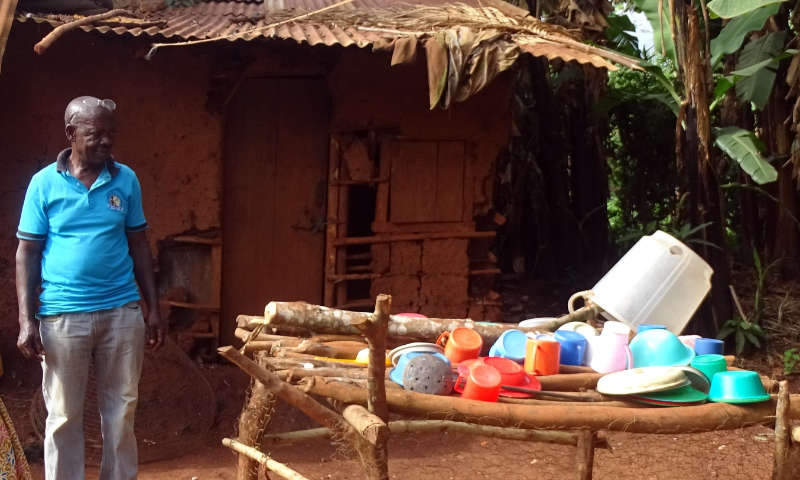Jaliah Nantabo, 28, mother of two, lives with her mother, sister, and three other children in Bujagaali Village in the Jinja District of East Central Uganda. Her homestead has a banana plantation at its lower side with scattered vegetable gardens she planted with her mother. A latrine stands a short distance from the plantation. Closer to the house is a newly constructed drying rack for kitchen utensils.
“We do a lot of rainwater harvesting, and this allows us to wash our hands often,” Nantabo said. “In the past we needed to save on water and washing hands was not a priority. But our VHT [Village Health Team member] keeps telling us about the importance of hand washing. He also talks about other practices such as sun drying utensils and using latrines to improve our hygiene and live healthier lives.”
The Health Burden of Poor Sanitation and Hygiene
In East Central Uganda, existing health challenges are exacerbated by poor sanitation and hygiene and unequal access to essentials such as hand washing stations and latrines.
USAID’s Regional Health Integration to Enhance Services – East Central Uganda (USAID RHITES–EC) Activity has been working with partners to carry out home improvement campaigns to improve community hygiene and sanitation. The goal is to reduce the incidence of hygiene-related diseases such as diarrhea, cholera, dysentery, and typhoid.
Approximately 3% of global deaths and 13% of deaths among children under five years old are attributable to poor water, sanitation, and hygiene (WASH) practices, according to the World Health Organization. Poor sanitation is a factor in more than half of global deaths from diarrheal diseases.
Bringing Hygiene Home
RHITES-EC uses interventions such as community sensitization dialogues to share the benefits of maintaining good hygiene and ways to improve sanitation and hygiene. In particular, communities are urged to establish latrines, functional hand washing stations, and outdoor racks for drying utensils and to harvest rainwater.
The limited availability of hand washing stations is directly correlated with a scarcity of available water in many homes. Families are encouraged to harvest rainwater to develop a water supply. When it rains, the children in a family or homestead put out large collection containers and later divide water into smaller containers to use in the home.
“When the communities understand the benefits of an intervention or health behavior, they start to implement it,” said Mugurusi John Kanakulya, a VHT member in Bujagaali Village, Jinja District. “We tell the communities we serve that hygiene drives away disease, which enables them to spend their money on other household needs rather than medicines to treat preventable diseases. We let them know that the resources they need to maintain good hygiene are within reach. Hand washing is gaining popularity now since almost every home can harvest rainwater.”

In-Person Visits and Customized Support
After holding community gatherings for the home improvement campaigns, Kanakulya’s VHT team conducts home-to-home visits. They carry out sanitation and hygiene assessments and determine the particular needs of a household to develop household action plans. The VHT delivers key WASH messages, supports lagging households, and documents uptake of positive WASH practices.
“Hygiene interventions are not a one-size-fits-all,” Kanakulya said. “Each home has its challenges. For some it is lack of a latrine. For others it is scarcity of water. The home-to-home visits have been critical in bringing about the change we want since each challenge requires specific interventions.”
Since the activity started, home-to-home improvement campaigns have been implemented in 119 villages to address hygiene practices, including hand and food hygiene, safe refuse disposal, and latrine construction and usage. The effort has led to the creation of 1,783 hand washing stations and 1,018 latrines, which means 61.5% of households now have latrine coverage, which is well above the national target of 40%.
And of course, household knowledge of water, sanitation, and hygiene practices across all target districts has improved, helping families like Nantabo’s lead healthier lives.



